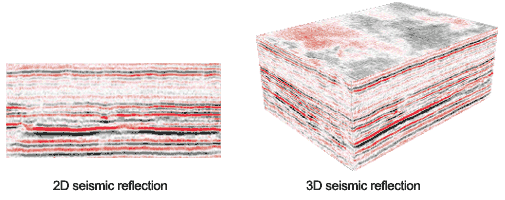The seismic technique is the geophysical method most-commonly used to define sub-surface structures. The most common implementation of this technique consists in reflection seismic with multiple coverage. This method provides imaging of the sub-surface in 2 or 3 dimensions. In order to obtain a more accurate depth tie than that provided by velocities resulting from surface seismic data, geophysicists use well data such as velocity survey and sonic log, and more recently information extracted from well seismic.

![]() Sub-surface
imaging. A) 2D seismic reflection. B) 3D seismic reflection.
Sub-surface
imaging. A) 2D seismic reflection. B) 3D seismic reflection.
from cd-rom "Reservoir and civil engineering geophysics", MARI
and CHAPELLIER (1999)
(BEICIP-FRANLAB document)
Well seismic methods are used for a better knowledge of the reservoir in the exploration phase, but these can also be used in the exploitation development phase with repetitive seismic for the study of the reservoir as a function of time (monitoring). Three types of well seismic techniques can be distinguished: surface shots with receivers in the well, shots in the well with receivers at the surface and shots in a well with receivers in another well.